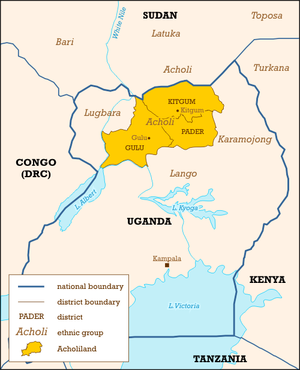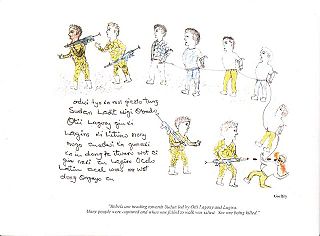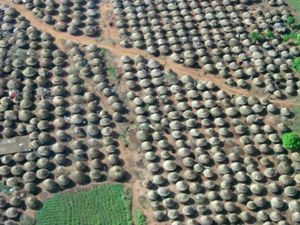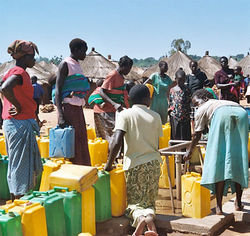
Lord's Resistance Army (1994-2002)
Encyclopedia

Uganda
Uganda , officially the Republic of Uganda, is a landlocked country in East Africa. Uganda is also known as the "Pearl of Africa". It is bordered on the east by Kenya, on the north by South Sudan, on the west by the Democratic Republic of the Congo, on the southwest by Rwanda, and on the south by...
saw the conflict intensifying due to Sudan
Sudan
Sudan , officially the Republic of the Sudan , is a country in North Africa, sometimes considered part of the Middle East politically. It is bordered by Egypt to the north, the Red Sea to the northeast, Eritrea and Ethiopia to the east, South Sudan to the south, the Central African Republic to the...
ese support to the rebels. There was a peak of bloodshed in the mid-1990s and then a gradual subsiding of the conflict. Violence was renewed beginning with the offensive by the Uganda People's Defence Force
Uganda People's Defence Force
The Uganda Peoples Defence Force , previously the National Resistance Army, is the armed forces of Uganda. The International Institute for Strategic Studies estimates the UPDF has a total strength of 40–45,000, and consists of land forces and an Air Wing.The IISS Military Balance 2007 says there...
in 2002.
For a seven year period beginning in 1987
Lord's Resistance Army (1987-1994)
The period from 1986 to 1994 of the Lord's Resistance Army insurgency is the early history of the ongoing insurgency of the Lord's Resistance Army rebel group in Uganda, which has been described as one of the most under-reported humanitarian crises in the world...
, the Lord's Resistance Army
Lord's Resistance Army
The Lord's Resistance Army insurgency is an ongoing guerrilla campaign waged since 1987 by the Lord's Resistance Army rebel group, operating mainly in northern Uganda, but also in South Sudan and eastern Democratic Republic of the Congo...
was a minor rebel group along the periphery of Uganda. However, two weeks after Museveni
Yoweri Museveni
Yoweri Kaguta Museveni is a Ugandan politician and statesman. He has been President of Uganda since 26 January 1986.Museveni was involved in the war that deposed Idi Amin Dada, ending his rule in 1979, and in the rebellion that subsequently led to the demise of the Milton Obote regime in 1985...
delivered his ultimatum of 6 February 1994, LRA fighters were reported to have crossed the northern border and established bases in southern Sudan with the approval of the Khartoum
Khartoum
Khartoum is the capital and largest city of Sudan and of Khartoum State. It is located at the confluence of the White Nile flowing north from Lake Victoria, and the Blue Nile flowing west from Ethiopia. The location where the two Niles meet is known as "al-Mogran"...
government. The end of the Bigombe peace initiatives marks a fundamental shift in the character of the Lord's Resistance Army, which is estimated to have consisted of 3,000 to 4,000 combatants at this time. This is the turning point at which the LRA becomes essentially the organization that operates today.
Sudanese support expands the scale of the conflict
Sudanese aid was a response to Ugandan support for the rebel Sudan People's Liberation ArmySudan People's Liberation Army
The Sudan People's Liberation Movement is a political party in South Sudan. It was initially founded as a rebel political movement with a military wing known as the Sudan People's Liberation Army estimated at 180,000 soldiers. The SPLM fought in the Second Sudanese Civil War against the Sudanese...
(SPLA) fighting in the civil war
Second Sudanese Civil War
The Second Sudanese Civil War started in 1983, although it was largely a continuation of the First Sudanese Civil War of 1955 to 1972. Although it originated in southern Sudan, the civil war spread to the Nuba mountains and Blue Nile by the end of the 1980s....
in the south of the country. Prior to this support, the LRA could be treated as a minor irritant in the outskirts of the country; now it also had to be considered a proxy force of the Khartoum government. Sudanese support allowed the LRA to increase the intensity of its operations beyond the level at which it was previously capable. Not only was a safe haven granted from which the LRA could launch attacks into Uganda, but Sudan also gave a large amount of arms, ammunition, land mines and other supplies. In return, the LRA was expected to deny territory to the SPLA and periodically participate in joint operations with the Sudanese army
Military of Sudan
The Sudanese Armed Forces numbers, according to 2007 IISS estimates, 104,800 members supported by 17,500 paramilitary personnel.It comprises Land Forces, a Navy, an Air Force, and the Popular Defence Force. It has also formed Joint Integrated Units with its rebel enemies the Sudan People's...
. The increased intensity of attacks through proxy forces led Uganda and Sudan to the brink of open hostilities in 1995.
Acholi civilians as targets

West Nile Bank Front
The West Nile Bank Front was a rebel armed force in Uganda under the command of Juma Oris. The WNBF began a campaign against President Yoweri Museveni in 1995...
, adopted the LRA tactics of abductions and raids. The strategy of forced recruitment was prompted by the lack of new volunteers to continue the conflict, and the fact that the young could be indoctrinated to support the LRA much more easily than adults. Furthermore, the LRA no longer had to spend much of its energies in the search for basic supplies now that they were supported by Sudan. The moral rationale was that since the Acholi adults had proven themselves untrustworthy, the LRA must cleanse the land of them and create a new society with the children. This philosophical approach, similar to that taken by the Khmer Rouge
Khmer Rouge
The Khmer Rouge literally translated as Red Cambodians was the name given to the followers of the Communist Party of Kampuchea, who were the ruling party in Cambodia from 1975 to 1979, led by Pol Pot, Nuon Chea, Ieng Sary, Son Sen and Khieu Samphan...
of Cambodia
Cambodia
Cambodia , officially known as the Kingdom of Cambodia, is a country located in the southern portion of the Indochina Peninsula in Southeast Asia...
, has been referred to as "auto-genocide."
The attacks on civilians have at least three strategic objectives. First, to deny the government information about its movements by forcing the rural population to flee. Second, to gather resources from the looted villages. Third and most bizarrely, to show the populace that the government is unable or unwilling to provide protection, and thus encourage people to support to the LRA. While the lack of security has certainly embittered many Acholi, this has not translated into support for the LRA forces that are attacking them.
There were numerous incidents that occurred after Sudanese support and are exceptional because of the large number of victims, the identity of the victims, or the circumstances of the incident. On April 22, 1995, Atiak Trading Center in northern Gulu District
Gulu District
Gulu District is a district in Northern Uganda. The district is named after its chief municipal, administrative and commercial center, the town of Gulu.-Location:...
was attacked and the Local Defense Forces routed. Over the course of the day between 170 and 220 civilians were killed in the absence of resistance from government forces. On March 8, 1996, a civilian convoy
Convoy
A convoy is a group of vehicles, typically motor vehicles or ships, traveling together for mutual support and protection. Often, a convoy is organized with armed defensive support, though it may also be used in a non-military sense, for example when driving through remote areas.-Age of Sail:Naval...
of over 20 vehicles with a military escort of 14 soldiers travelling west on the Karuma
Karuma
-Location:Karuma is located on the Victoria Nile, at the present location of the Karuma Falls. This location is adjacent to the location where the Masindi-Gulu Highway, crosses the river Nile. It is approximately , by road, northeast of Masindi and approximately , by road, south of Gulu...
-Pakwach
Pakwach
- Location :Pakwach is located in Nebbi District, in West Nile sub-region, in Northern Uganda. It is situated approximately , by road, southeast of Arua, the largest town in West Nile. This location lies along the western bank of the Albert Nile, approximately , by road, southwest of Gulu, the...
road was ambushed. Between 50 and 110 civilians were killed, most after the escort had been overcome. Some were executed; others were killed after they refused to exit their buses and explosives were thrown inside. The LRA carried out three separate attacks on July 13 to July 14, 1996 upon a settlement of Sudanese refugees in southern Kitgum (now Pader District
Pader District
Pader District is a district in Northern Uganda. It is named after Pader, the chief municipal, administrative and commercial town in the district, where the district headquarters are located.-Location:...
) administered by the Office of the UN High Commissioner for Refugees. Approximately 100 refugees were killed. In the Lokung/Palabek massacre from January 7 to January 12, 1997, up to 412 civilians were killed in and around the subcounties of Lokung and Palabek in northwest Kitgum. There were no opposing forces and most victims were bludgeoned or hacked to death.
The most famous attack of this period were the St. Mary's College/Aboke abductions
Aboke abductions
The Aboke abductions were the abductions of 139 female secondary school students by rebels of the Lord's Resistance Army from St. Mary's College boarding school in Aboke, northern Apac District, Uganda on 10 October 1996. The deputy head mistress of the college, Sister Rachele Fassera of Italy,...
on October 10, 1996. At about 2 a.m. about 200 armed rebels broke into St. Mary's College in Aboke
Aboke
Aboke is a town in northern Apac District, Uganda.It is known for being the site of the Aboke abductions in October 1996 from St. Mary's College of 139 schoolgirls by rebels of the Lord's Resistance Army....
, northern Apac
Apac
Apac is a town in Apac District, Northern Uganda. It is the 'chief town' of the district and the district headquarters are located there. The district is named after the town.-Location:...
District, and abducted 139 secondary school girls between 13 and 16 years of age before leaving at about 5 a.m. At 7 a.m., the deputy head mistress of the college, Sister Rachele Fassera, pursued the rebels and negotiated the release of 109 of the girls. Five of the thirty remaining girls died in captivity; all but two eventually made their escape, as of 2006.
Government forces have also been the focus of controversy. On August 31, 1995, thirteen civilians, some with their hands tied behind their backs, were killed in a government gunship attack on an LRA column near Lokung, northwest Kitgum
Kitgum
Kitgum is a municipality in Kitgum District, in Northern Uganda. The town is administered by Kitgum Town Council, an Urban Local Government within Kitgum District Administration...
. Sixteen LRA combatants were also killed. Critics charged reckless disregard for abductee lives; the government claimed the killings were accidental and unintentional. The military contributed to mob killings in Gulu Town on August 16, 1996. Four LRA suspects were turned over to an Acholi mob that beat them to death. The suspects were under government custody and are reported to have been turned over to the mob in the presence of senior Uganda Fourth Division officers.
The deaths of two Acholi elders on 8 June 1996 remains a mystery. Mr. Okot Ogony of Cwero, eastern Gulu, Chairman of the Peace Commission of the Council of Acholi Chiefs, and Mr. Olanya Lacony, a respected elder from Kac-Goma, southwestern Gulu, were found murdered near Cwero in still unexplained circumstances. They were the leaders of a local initiative to restart the peace talks that had collapsed in February 1994 and had the approval of the President of Uganda
President of Uganda
-List of Presidents of Uganda:-Affiliations:-See also:*Uganda*Vice President of Uganda*Prime Minister of Uganda*Politics of Uganda*History of Uganda*Political parties of Uganda...
and an invitation from the LRA. Some blame the LRA, while others point to corrupt National Resistance Army
National Resistance Army
The National Resistance Army , the military wing of the National Resistance Movement , was a rebel army that waged a guerrilla war, commonly referred to as the Luwero War or "the war in the bush", against the government of Milton Obote, and later that of Tito Okello.NRA was supported by Muammar...
officers.
"Protected villages" created in 1996

Internally displaced person
An internally displaced person is someone who is forced to flee his or her home but who remains within his or her country's borders. They are often referred to as refugees, although they do not fall within the current legal definition of a refugee. At the end of 2006 it was estimated there were...
by the conflict, they resented being ordered into camps. A strategy of resettlement, or "villagization
Villagization
Villagization is the resettlement of people into designated villages by government or military authorities....
", is a common anti-insurgent technique, used extensively for example by the United States
United States
The United States of America is a federal constitutional republic comprising fifty states and a federal district...
throughout the Indian Wars
Indian Wars
American Indian Wars is the name used in the United States to describe a series of conflicts between American settlers or the federal government and the native peoples of North America before and after the American Revolutionary War. The wars resulted from the arrival of European colonizers who...
to isolate Native Americans
Native Americans in the United States
Native Americans in the United States are the indigenous peoples in North America within the boundaries of the present-day continental United States, parts of Alaska, and the island state of Hawaii. They are composed of numerous, distinct tribes, states, and ethnic groups, many of which survive as...
in reservations
Indian reservation
An American Indian reservation is an area of land managed by a Native American tribe under the United States Department of the Interior's Bureau of Indian Affairs...
. It is intended to free up troops that would otherwise be attempting to defend innumerable small communities and to deny the rebels access to resources. Nevertheless, the population continues to be attacked by the LRA even within the "protected camps." The camps are also crowded, unsanitary, and miserable places to live.
A culture of peace and a gradual subsiding
The bloodshed in 1995 to 1996 appears to have convinced the population that a negotiated solution was the only acceptable option. This is what one writer calls the emergence of "a culture of peace." As most of the LRA combatants are abducted children, a military solution is widely seen by the Acholi as a massacre of victims. Government attempts to destroy the rebels are thus viewed as another cause for grievance by the Acholi. The moral ambiguity of this situation, in which abducted young rebels are both the victims and perpetrators of brutal acts, is vital in understanding the current conflict.Meanwhile, in 1997 the Sudanese government of the National Islamic Front had begun to back away from its previous hard-line stance. This was prompted by the leadership of new President Omar al-Bashir
Omar al-Bashir
Lieutenant General Omar Hassan Ahmad Al-Bashir is the current President of Sudan and the head of the National Congress Party. He came to power in 1989 when he, as a brigadier in the Sudanese army, led a group of officers in a bloodless military coup that ousted the government of Prime Minister...
, who wanted to ensure export of the oil from the newly developed fields being wrested from SPLA control. The U.S. had also taken a more proactive stance against the National Islamic Front government. U.S. pressure on Sudan intensified following the 1998 bombing of the American embassies in Kenya
Kenya
Kenya , officially known as the Republic of Kenya, is a country in East Africa that lies on the equator, with the Indian Ocean to its south-east...
and Tanzania
Tanzania
The United Republic of Tanzania is a country in East Africa bordered by Kenya and Uganda to the north, Rwanda, Burundi, and the Democratic Republic of the Congo to the west, and Zambia, Malawi, and Mozambique to the south. The country's eastern borders lie on the Indian Ocean.Tanzania is a state...
by al-Qaeda
Al-Qaeda
Al-Qaeda is a global broad-based militant Islamist terrorist organization founded by Osama bin Laden sometime between August 1988 and late 1989. It operates as a network comprising both a multinational, stateless army and a radical Sunni Muslim movement calling for global Jihad...
operatives with links to Sudan. Over the next several years, Khartoum is believed to have substantially curtailed aid to the LRA. In 1999 the Carter Center
Carter Center
The Carter Center is a nongovernmental, not-for-profit organization founded in 1982 by former U.S. President Jimmy Carter and his wife Rosalynn Carter. In partnership with Emory University, The Carter Center works to advance human rights and alleviate human suffering...
mediated the Nairobi Agreement
Nairobi Agreement, 1999
The 1999 Nairobi Agreement was a deal signed by Presidents Yoweri Museveni of Uganda and Omar al-Bashir of Sudan in Nairobi, Kenya, on 8 December 1999...
between Uganda and Sudan, which restored diplomatic relations in 2001.

The sudden appearance of LRA units in June 2001 who contacted local government officials to discuss the possibility of dialogue created a flurry of speculation that the LRA was tiring of their insurgency. The Uganda People's Defense Force – the renamed NRA – created a demilitarized zone for the talks, a measure that had the implicit approval of President Museveni. The talks were exploratory in nature and the LRA units eventually returned to Sudan. However, analysts believed that they were initiated at the behest of Kony and indicated the most promising diplomatic environment since the collapse of the Bigombe talks in 1994.
Following the al-Qaeda attacks in 2001
September 11, 2001 attacks
The September 11 attacks The September 11 attacks The September 11 attacks (also referred to as September 11, September 11th or 9/119/11 is pronounced "nine eleven". The slash is not part of the pronunciation...
upon the World Trade Center
World Trade Center
The original World Trade Center was a complex with seven buildings featuring landmark twin towers in Lower Manhattan, New York City, United States. The complex opened on April 4, 1973, and was destroyed in 2001 during the September 11 attacks. The site is currently being rebuilt with five new...
and The Pentagon
The Pentagon
The Pentagon is the headquarters of the United States Department of Defense, located in Arlington County, Virginia. As a symbol of the U.S. military, "the Pentagon" is often used metonymically to refer to the Department of Defense rather than the building itself.Designed by the American architect...
in the U.S., the relationship between Sudan and Uganda abruptly changed. The NIF government was anxious to avoid any blame that may be attached to them for their offering of sanctuary to al-Qaeda leader Osama Bin Laden
Osama bin Laden
Osama bin Mohammed bin Awad bin Laden was the founder of the militant Islamist organization Al-Qaeda, the jihadist organization responsible for the September 11 attacks on the United States and numerous other mass-casualty attacks against civilian and military targets...
for several years in the 1990s. Also, following the LRA's designation as a terrorist
Terrorism
Terrorism is the systematic use of terror, especially as a means of coercion. In the international community, however, terrorism has no universally agreed, legally binding, criminal law definition...
organization by the U.S. State Department
United States Department of State
The United States Department of State , is the United States federal executive department responsible for international relations of the United States, equivalent to the foreign ministries of other countries...
on 5 December 2001, Sudan agreed to stop supplying aid to the LRA.
Cross-border tensions were dialed down as support to proxy forces fell. The LRA itself appeared settled into their Sudanese base camps and only periodically crossed the border. Some of the hundreds of thousands of civilians displaced
Internally displaced person
An internally displaced person is someone who is forced to flee his or her home but who remains within his or her country's borders. They are often referred to as refugees, although they do not fall within the current legal definition of a refugee. At the end of 2006 it was estimated there were...
by the war began to return to their homes. The number of people displaced by the conflict declined to about half a million, and people began to talk openly of the day when the "protected camps" would be disbanded.

